eOrganic authors:
Lorraine P. Berkett, University of Vermont
Renae E. Moran, University of Maine
M. Elena Garcia, University of Arkansas
Heather M. Darby, University of Vermont
Robert L. Parsons, University of Vermont
Terence L. Bradshaw, University of Vermont
Sarah L. Kingsley-Richards, University of Vermont
Morgan L. Griffith, University of Vermont
Contact address: Lorraine.Berkett@uvm.edu
Introduction
Apples are an important component of New England's diversified agriculture. Sustainable and profitable organic apple production in New England has been a long-existing goal of organic farming in the region. Many more apple growers are interested in producing organic apples than the small numbers of certified organic orchards reflect. The small number of certified organic orchards reflects, in part, the insect and horticultural challenges of organic apple production in the region and the disease challenges associated with the predominant cultivar grown in New England (McIntosh). The recent shift in consumer preference for newer cultivars has led to the planting of different apple cultivars in the region which have different insect and disease susceptibility. In addition, recent research has identified potential alternatives for insect and horticultural obstacles to organic apple production. Therefore, growers want to know the potential for sustainable and profitable organic production with the different cultivars now being planted in the region.
About the OrganicA Project
In 2006, after extensive stakeholder input, we initiated a trans-disciplinary, multi-state research project—the OrganicA Project—to incorporate available knowledge and examine organic apple production systems that reflect consumer preferences for newer cultivars and organically grown food, while maintaining sustainable and profitable orchards. The project is evaluating the opportunities and challenges of organic production within the two major production systems growers are using to change to new cultivars and with five of the top apple cultivars that growers identified as important to the future of the industry. The orchard systems are: (i) a new orchard planted with young trees purchased from a nursery and (ii) a top-grafted orchard—an established, older orchard onto which new cultivars are grafted. The cultivars being studied in replicated plots in each orchard system are: Zestar!, Ginger Gold, Honeycrisp, Macoun, and Liberty, a scab-resistant cultivar.
Phase 1 of the project ran from 2006 to 2009 and focused primarily on cultural, disease, and arthropod management; soil health; and economic evaluations during orchard establishment. During this phase, we also created the project website at: uvm.edu/organica. To learn more about Phase I of the project, please see:
Since the implementation of Phase I, all aspects of the OrganicA Project have received high praise. The project has both increased knowledge and changed behavior of program participants. The OrganicA Project has become a leading Internet resource for organic information. Research results have been presented at regional workshops involving growers, scientists, extension personnel, and agricultural consultants, and at national and international scientific conferences. This long-term project was nationally ranked #1 by the USDA Organic Agriculture Research & Extension Program upon review in 2009.
Phase 2 of the project began in 2009 and includes investigation during the early-bearing years of the two organic orchard systems. The project is currently in this phase. The following are the objectives of the OrganicA Project during Phase 2.
Current Project Objectives
Research
Objective 1. Continue to evaluate ‘new’ apple cultivars and incorporate research-generated knowledge of apple ecosystem dynamics into organic production systems to determine sustainability and profitability.
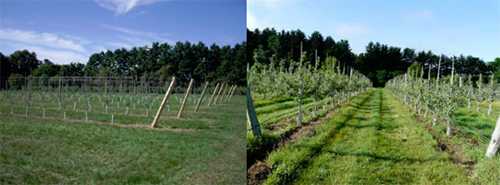
Figure 1. Orchard planted with Ginger Gold, Honeycrsip, Liberty, Macoun and Zestar! trees in 2006 at the University of Vermont Horticulture Farm (left). View of this organically-certified orchard in 2011 (right). Photo credit: L. P. Berkett, University of Vermont.
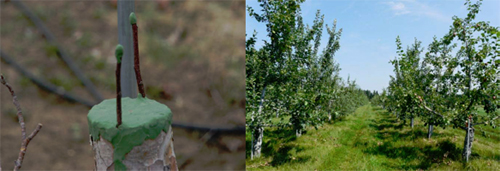
Figure 2. The same five cultivars were top-grafted onto existing trees in an 18 year old orchard at the University of Vermont Horticulture Farm in 2006 (left). The organically-certified orchard as it appears now (right). Photo credit: L. P. Berkett, University of Vermont.
Extensive data are being collected in the two orchard systems to determine differences among cultivars. Data includes: tree growth and development metrics; harvest and yield data; disease incidence and severity; arthropod pest damage and population levels; beneficial arthropod levels; measurements of tree health; measurements of soil health; and economic inputs (detailed records have been kept on amount of labor used, tasks performed and time required, cost of supplies, maintenance, pest management, harvest, and so forth, for each orchard system).
Objective 2. Field test commonly recommended organic foliar nutrient sources and evaluate their impacts on fruit yield, quality, tree nutrition and health including impact on disease and arthropod pests.
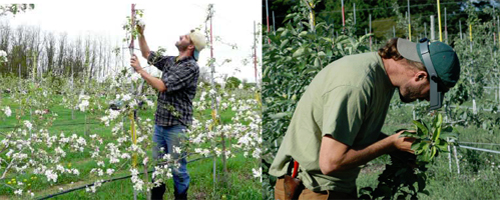
Figure 3. Terence Bradshaw, a M.S. graduate student, conducted research to assess the effects of kelp-extract biostimulants on tree growth, yield, and fruit quality; arthropod incidence and damage; and disease incidence. Photo credit: L. P. Berkett, University of Vermont.
Objective 3. Evaluate the benefits of different ground cover strategies in promoting tree health, plant and soil water status, and yield and fruit quality.
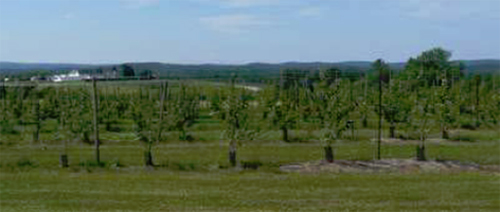
Figure 4. Research orchard at the University of Maine's Highmoor Farm where organic ground cover research is being conducted by Dr. Renae Moran. Photo credit: Renae Moran, University of Maine.
Outreach
Objective 4. Continue to collaboratively develop and implement with stakeholders a multi-dimensional extension program that addresses their priorities and needs, enables whole farm planning, improves competitiveness, and enhances the ability of growers to grow and market high quality organic apples.
Research results have been presented at numerous grower workshops/orchard tours and scientific meetings in the state, region, the Midwest, Italy, France, and Portugal.
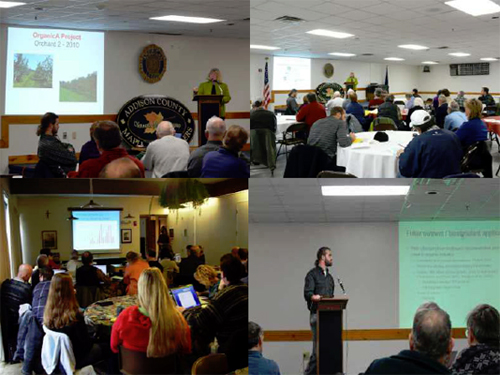
Figure 5. Presentations at state and regional apple grower meetings and research/extension meetings. Photo credit: L. P. Berkett, University of Vermont.

Figure 6. Orchard tours and demonstrations to commercial growers, home orchardists, researchers, and agricultural consultants from Vermont, New York, Massachusetts, New Hampshire, and Quebec, Canada. Photo credit: L. P. Berkett, University of Vermont.
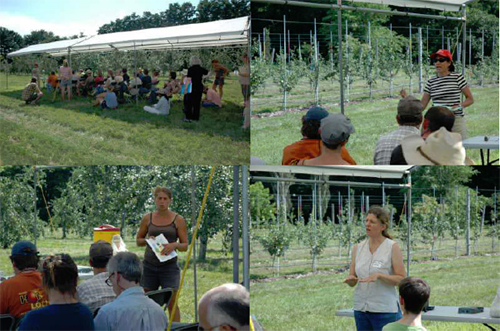
Figure 7. OrganicA researchers presenting results and insights from the organic apple orchards. Photo credit: L. P. Berkett, University of Vermont.
In addition, ‘Orchard Observations’ blog postings containing time-sensitive information and insights during the growing season are sent out to OrganicA listserve subscribers. They are also posted on the OrganicA website at:
http://www.uvm.edu/~organica/ListservesBlogs/listservesblogs.htm
OrganicA on the Web
Visit the project website for more information on The OrganicA Project and organic apple production: http://www.uvm.edu/organica. Videos from The OrganicA Project organic orchards can be found on our YouTube channel at: https://www.youtube.com/user/UVMOrganicA
Funding Sources
Funding for the project has been provided by the following sources:
- USDA Organic Agriculture Research & Extension Initiative
- University of Vermont
- University of Maine
- University of Arkansas
- USDA NIFA Integrated Pest Management Program
- Vermont Tree Fruit Growers’ Association



